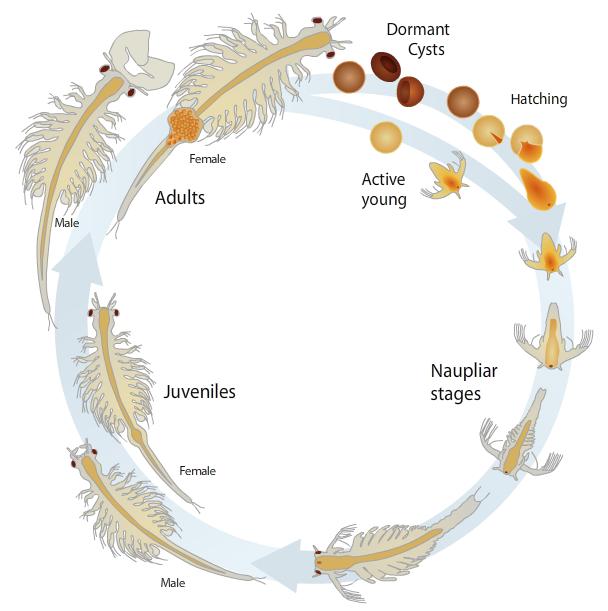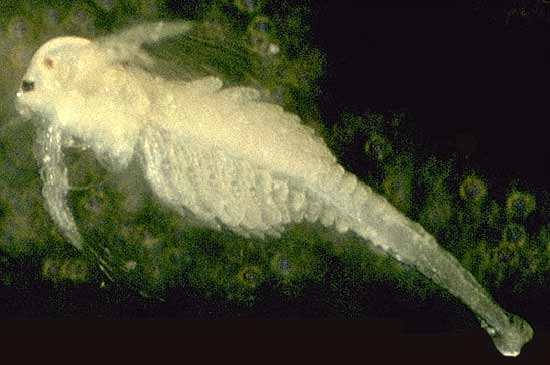
Courtesy University of Utah
Genetic Science Learning Center
Hi, this is Mark Larese-Casanova from the Utah Master Naturalist Program at Utah State University Extension.
I can still remember the colorful advertisements for Sea Monkeys in the back of comics books that I read as a child. For just $1.75, I could have a “bowl full of happiness!” It wasn’t until I visited Great Salt Lake thirty years later that I realized what sea monkeys really were. They certainly weren’t tiny, web-footed humans, and they definitely didn’t have little crown-like antennae. But, it was exciting to think that we have an enormous Sea Monkey aquarium right here in Utah.
Sea Monkeys are actually brine shrimp of the genus Artemia, and Great Salt Lake is full of the species Artemia franciscana. These tiny crustaceans, along with the brine fly’s aquatic larvae, are the foundation of the Great Salt Lake Ecosystem. Millions of birds visit Great Salt Lake each year to feed on brine shrimp during migration or while nesting.

from the Great Salt Lake
Courtesy USGS
Not much can live in Great Salt Lake, with its salt concentrations as high as 25%. But by adapting to these conditions, brine shrimp avoid many predators and have little competition for the abundant algae and bacteria that grow there.
Beginning in late winter or early spring, as the water temperature increases and there is an influx of fresh water to the lake, brine shrimp hatch from cysts, which are hard-shelled dormant eggs. The brine shrimp larva, also called a nauplius, survives on a yolk sack for the first 12 hours, but then feeds on algae as it grows into an adult.
Some species of Artemia have only females, but the Great Salt Lake population has both males and females. The male can be distinguished by his ‘grasper’ antennae, which almost look like a giant handlebar moustache, and the female can often be seen with two small, orange or pink egg sacs at the base of her tail. When conditions in the lake are good, such as with high oxygen and relatively low salt concentrations, female brine shrimp will give birth to live nauplii. But, if salt concentrations increase due to drought in summer, or when water temperature drops in late fall, females switch to making more cysts to ensure the survival of future generations. As winter passes, and spring starts to make an appearance, the life cycle of the brine shrimp starts all over again.
To learn more about brine shrimp, be sure the visit the Great Salt Lake Institute’s web site at greatsaltlakeinstitute.org. I encourage you to visit Antelope Island State Park where you can catch brine shrimp from the marina on the north end of the island. All you need is a bucket… and a little sense of adventure.
Credits:
Photos: Courtesy USGS https://ut.water.usgs.gov/shrimp/
Brine Shrimp Lifecycle, Courtesy University of Utah Genetic Science Learning Center
Theme: Courtesy & Copyright Don Anderson Leaping Lulu
Text & Voice: Mark Larese-Casanova
Additional Reading:
USGS, Utah Water Science Center, Brine Shrimp and Ecology of Great Salt Lake. (Courtesy Internet Archive Wayback Machine, Apr 15, 2008) https://wildaboututah.org/wp-content/uploads/080415-Wayback-USGS-Brine-Shrimp-and-Ecology-of-Great-Salt-Lake.pdf Formerly: https://ut.water.usgs.gov/greatsaltlake/shrimp/
Brine Shrimp, Genetic Science Learning Center, University of Utah, https://learn.genetics.utah.edu/content/gsl/foodweb/brine_shrimp/
Salt Lake Brine Shrimp, https://saltlakebrineshrimp.com/harvest/

